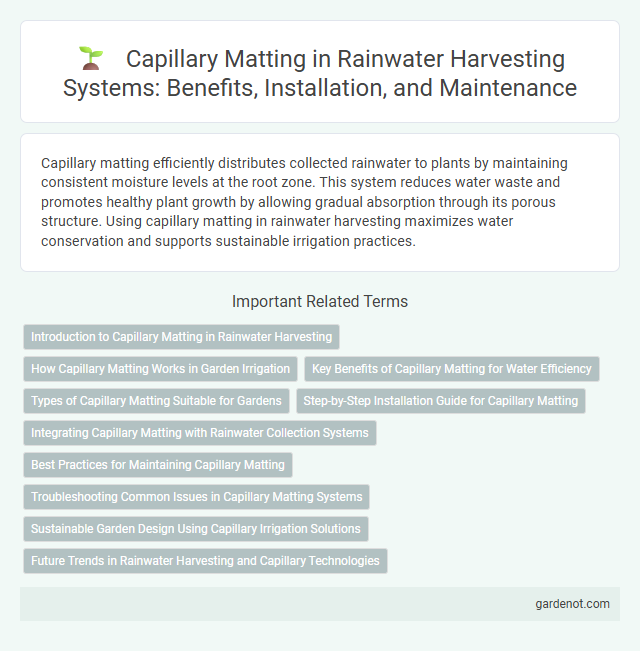Capillary matting efficiently distributes collected rainwater to plants by maintaining consistent moisture levels at the root zone. This system reduces water waste and promotes healthy plant growth by allowing gradual absorption through its porous structure. Using capillary matting in rainwater harvesting maximizes water conservation and supports sustainable irrigation practices.
Introduction to Capillary Matting in Rainwater Harvesting
Capillary matting is an efficient medium used in rainwater harvesting systems to promote uniform water distribution and retention. This porous material enhances water absorption through capillary action, allowing stored rainwater to be gradually released to plants or soil, reducing water wastage. Its application improves irrigation efficiency and supports sustainable water management in both agricultural and urban settings.
How Capillary Matting Works in Garden Irrigation
Capillary matting operates by utilizing the natural wicking properties of its fibers to evenly distribute collected rainwater directly to plant roots. This method minimizes water waste and maintains consistent soil moisture, enhancing garden irrigation efficiency. By creating a controlled water reservoir beneath plants, it supports sustainable rainwater harvesting practices for healthier garden growth.
Key Benefits of Capillary Matting for Water Efficiency
Capillary matting enhances water efficiency by delivering consistent moisture directly to plant roots, reducing water wastage through evaporation and runoff. Its highly absorbent structure promotes even water distribution, supporting healthier plant growth with lower irrigation frequency. This sustainable technique conserves rainwater effectively, making it ideal for efficient rainwater harvesting systems.
Types of Capillary Matting Suitable for Gardens
Capillary matting types suitable for gardens include natural materials like coconut coir and jute, known for their excellent water retention and breathability. Synthetic options such as polypropylene and polyester mats offer durability and resistance to mold, making them ideal for long-term outdoor use. Selecting the appropriate capillary matting enhances efficient rainwater distribution and root hydration in garden irrigation systems.
Step-by-Step Installation Guide for Capillary Matting
Begin by measuring the area to ensure the capillary matting fits precisely within the rainwater harvesting system. Lay the matting flat on a clean surface, then connect the matting to the water supply line to enable efficient water absorption. Secure the edges with clips or weights to prevent shifting and ensure uniform moisture distribution throughout the matting.
Integrating Capillary Matting with Rainwater Collection Systems
Integrating capillary matting with rainwater collection systems enhances efficient water distribution by evenly dispersing harvested rainwater directly to plant roots through controlled capillary action. This method reduces water wastage and optimizes moisture retention, making it ideal for sustainable irrigation in greenhouses, urban gardens, and landscaping projects. The synergy between capillary matting and rainwater harvesting supports water conservation goals while promoting healthier plant growth and reducing reliance on traditional irrigation.
Best Practices for Maintaining Capillary Matting
Best practices for maintaining capillary matting in rainwater harvesting systems include regular inspection for blockages and debris to ensure efficient water distribution. Periodic cleaning with gentle water jets prevents algae buildup, maintaining optimal capillary action. Maintaining proper moisture levels and avoiding overwatering helps prolong the lifespan and functionality of the matting.
Troubleshooting Common Issues in Capillary Matting Systems
Clogging in capillary matting systems often results from sediment build-up or algae growth, requiring regular flushing and use of filtered rainwater to maintain optimal water flow. Uneven water distribution can cause dry spots or waterlogging, which is typically resolved by checking for blockages and ensuring the matting is properly connected to the water source. Inspecting for tears or damaged fibers is essential as such physical defects compromise the matting's wicking efficiency, necessitating timely repairs or replacement to sustain effective rainwater harvesting.
Sustainable Garden Design Using Capillary Irrigation Solutions
Capillary matting provides an efficient means of rainwater harvesting by allowing slow, controlled water release to plant roots, minimizing evaporation and runoff. This sustainable garden design solution reduces water waste and supports healthy plant growth by maintaining consistent soil moisture. Integrating capillary irrigation with rainwater collection systems promotes eco-friendly landscaping and reduces reliance on external water sources.
Future Trends in Rainwater Harvesting and Capillary Technologies
Future trends in rainwater harvesting emphasize the integration of capillary matting technologies to enhance water distribution efficiency and reduce evaporation loss in storage systems. Advancements in nano-engineered capillary materials improve water absorption and retention capabilities, enabling more sustainable urban irrigation and greywater recycling. Smart sensor integration with capillary mats optimizes real-time water management, supporting climate-resilient rainwater harvesting infrastructure.
Capillary matting Infographic

 gardenot.com
gardenot.com